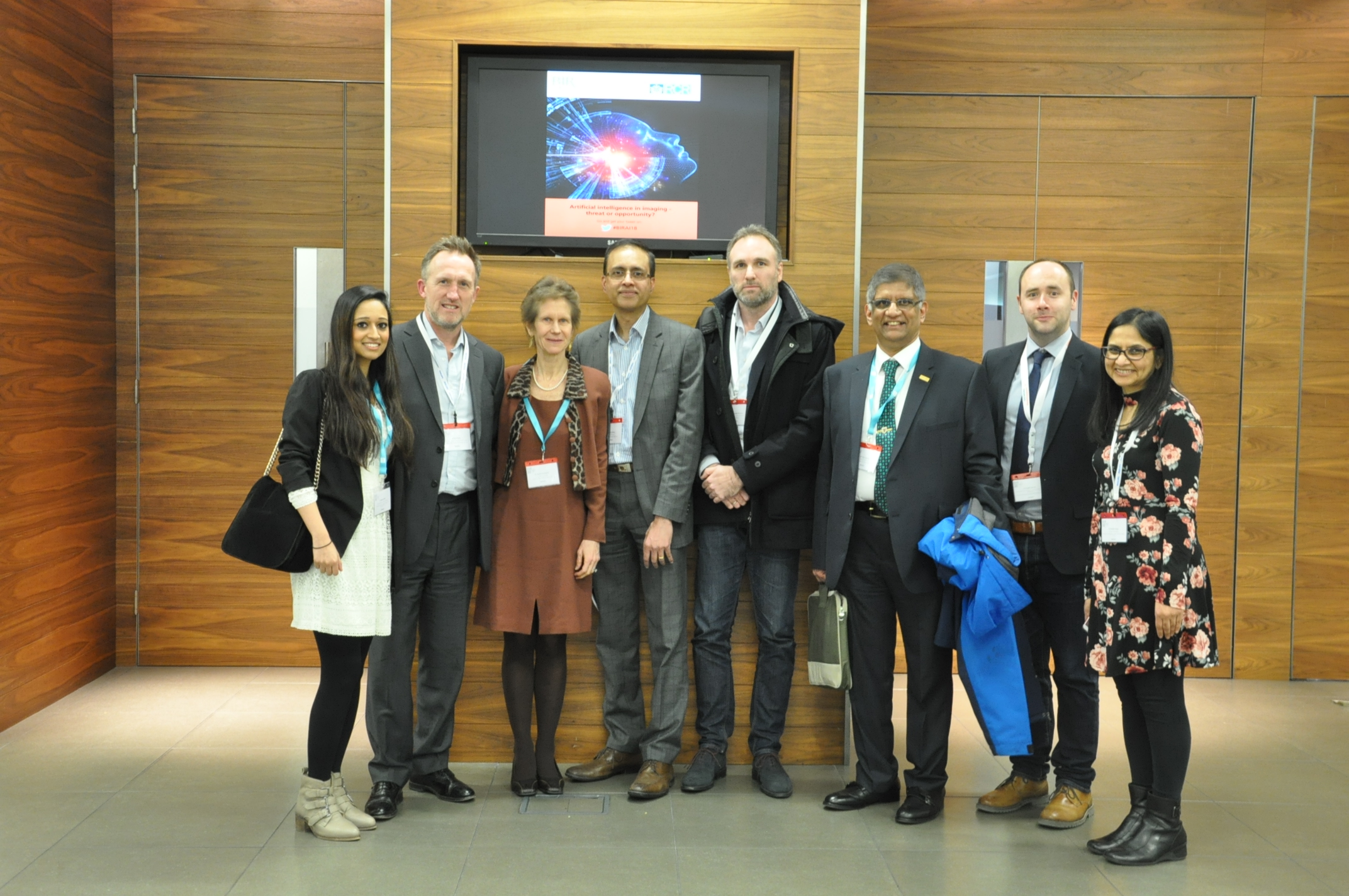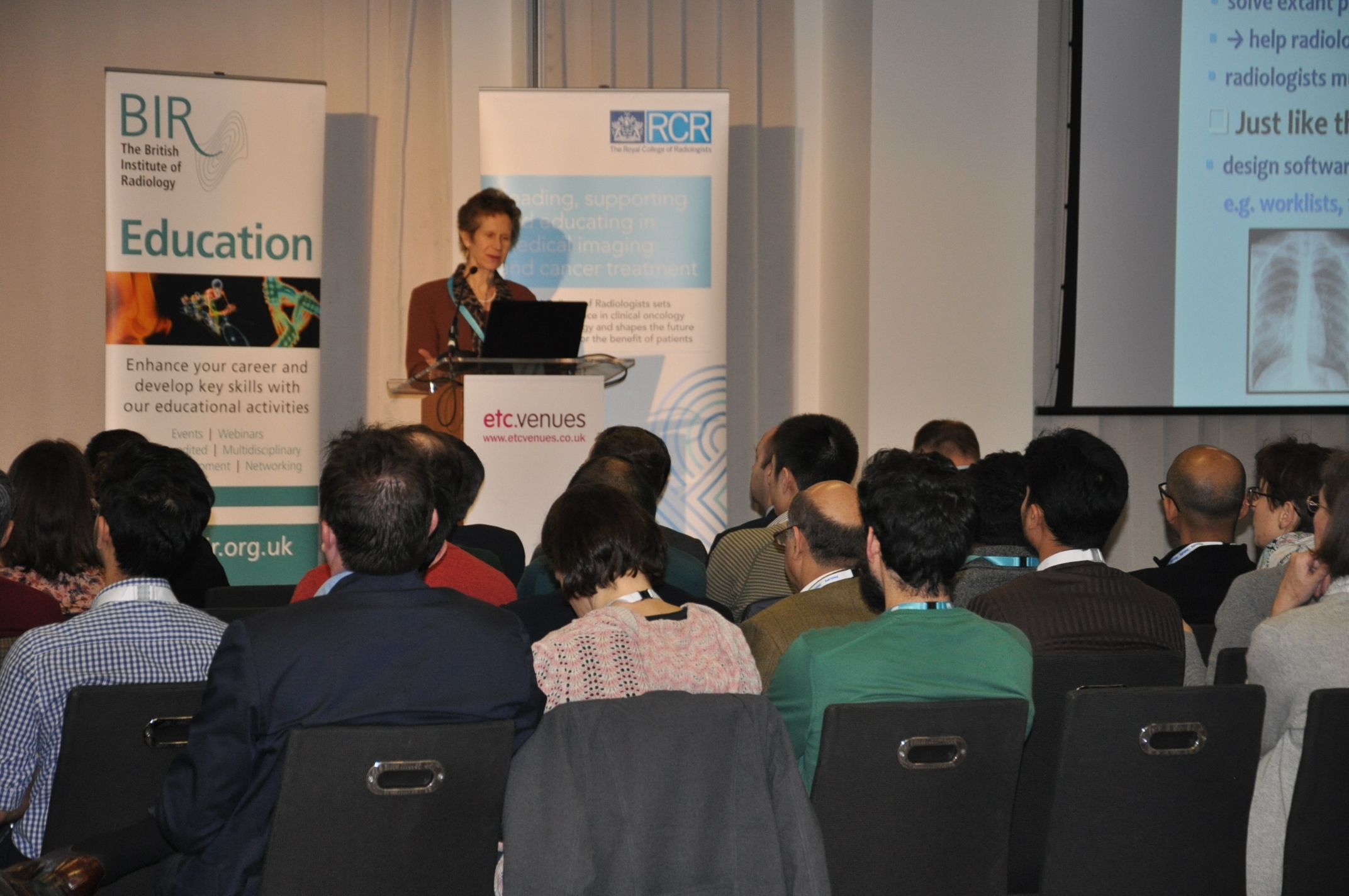
The growing interest around the use of Artificial Intelligence (AI) in radiology was evidenced by over 180 delegates attending this meeting on 23 March 2018 at etc. venues St Paul’s, London. This fascination may have been spurred on by the quote in late 2016 by Geoff Hinton, the British cognitive psychologist and computer scientist widely revered as the godfather of neural networks, who stated that it is “obvious that we should stop training radiologists right now” as AI would put them out of jobs in the next 5-10 years. Given that there is currently a 9% vacancy rate for consultant radiologists, maybe AI can help provide a solution.
The day offered both objective and optimistic views on the future of AI and provided an overview and discussion from some of the top experts in the field to an audience of professionals including radiology trainees, physicists, clinical scientists and consultant radiologists.
 Dr Nicola Strickland, President of the RCR was the first to speak, encouraging the AI community to concentrate on the “low-hanging fruit”, such as identifying “normal” plain X-rays, to solve existing problems and enhance efficiency and performance. She touched upon several challenges associated with the use of AI including the requirements for vast databases of clean, e.g. double-reported, labelled and anonymised data. She highlighted the regulation of AI technology, e.g. what is an acceptable level of accuracy, particularly with software that is constantly evolving, and who is to blame when errors occur?
Dr Nicola Strickland, President of the RCR was the first to speak, encouraging the AI community to concentrate on the “low-hanging fruit”, such as identifying “normal” plain X-rays, to solve existing problems and enhance efficiency and performance. She touched upon several challenges associated with the use of AI including the requirements for vast databases of clean, e.g. double-reported, labelled and anonymised data. She highlighted the regulation of AI technology, e.g. what is an acceptable level of accuracy, particularly with software that is constantly evolving, and who is to blame when errors occur?
Dr Hugh Harvey, Clinical Director at Kheiron Medical and Chair of the RCR Clinical Informatics Special Interest Group then talked about his  vision of empowering the UK to become the world leader in radiology AI. He reminded the audience that the NHS has a massive amount of high-quality cradle-to-grave data. He highlighted the government’s recent Life Sciences Industrial Strategy (https://www.gov.uk/government/publications/life-sciences-industrial-strategy) which recommends 4–6 centres of excellence for specific themes. He proposed that one of these needed to be AI. His four principles of UK success in AI were: NHS data under NHS control; research based only in the UK; products should benefit the NHS; and product validation should be performed in the UK.
vision of empowering the UK to become the world leader in radiology AI. He reminded the audience that the NHS has a massive amount of high-quality cradle-to-grave data. He highlighted the government’s recent Life Sciences Industrial Strategy (https://www.gov.uk/government/publications/life-sciences-industrial-strategy) which recommends 4–6 centres of excellence for specific themes. He proposed that one of these needed to be AI. His four principles of UK success in AI were: NHS data under NHS control; research based only in the UK; products should benefit the NHS; and product validation should be performed in the UK.
Dr Julian Elford gave a global perspective on AI in radiology using the Gartner Hype Cycle (https://www.gartner.com/technology/research/methodologies/hype-cycle.jsp) to illustrate the evolution of AI. He, like others, stressed the importance of data cleansing, labelling and validation as well as the importance of growing the UK AI industry.
Dr Neelam Dugar gave a whistle-stop tour of several academic and commercial AI offerings. She emphasised that optimisation of acquisition is crucial to a successful AI deployment and that PACS vendors need to incorporate AI into a better image reading workflow. She also discussed the use of AI enabled content aggregation that extracts information from diverse healthcare data silos to help radiologists create actionable imaging reports.
Mr Steve Tolle Global VP for Strategy and Business Development for IBM Watson Health Imaging gave the first industry perspective on AI. He stated that there were more than 110 imaging AI companies with around 25% having some form of FDA regulatory clearance. He expected the worldwide radiology AI market would be worth more than $650M by 2021. He presented four critical tests for the use of AI: is there a problem to solve? can AI contribute to the solution? what will doctors use? and what will an organisation pay for? He encouraged the audience to ignore the hype around AI and to ask tough questions of their potential AI vendors, in particular about the data used to train and test their algorithms.
Dr Chris Austin,Clinical Director, Imaging AI and Analytics for GE Healthcare emphasised that Radiology is a team sport. He explained how GE partners with world-class organisations like the Boston-based Partners HealthCare system and UCSF to provide ideas and data to help drive algorithm development.
Dr Peter Kecskemethy, Co-founder and CEO of Kheiron Medical discussed the use of advanced machine learning for mammography. He emphasised the need to work closely with radiologists, and to undertake responsible engineering as well as communication. He emphasised that healthcare is data-driven, and its language is statistics. He warned against getting excited about the results from machine learning algorithms without statistical validation, and that the limitations of AI should always be kept in mind.
Professor Giovanni Montana, Professor of Biostatistics and Bioinformatics at the University of Warwick then talked about his group’s work on the use of AI for chest X-ray interpretation. Using over 800,000 radiographs acquired between 2005 and 2017 together with free text from Radiology Information Systems, they developed a computer vision algorithm that could classify images into four priority classes: normal; non-urgent; urgent; and critical. The system had a reported sensitivity and specificity of 94.5% and 71.3% respectively for the detection of normal.
Mr Simon Rasalingham and Dr Thomas Naunton Morgan CEO and CMO respectively of behold.AItalked about their mission to provide a “super-human radiologist’” that uses their AI-based red dotTM prioritisation service for plain film and CT head reporting. They claimed their CE-marked cloud solution can achieve a 50% reduction in in-sourcing costs.
The final presentation was given by Dr Ian Francis who talked about the impact of AI on future radiology training. He talked about the Radiologist as a “data wrangler” tied to their PACS workstation who doesn’t see patients and has limited interaction with other clinicians who have, in some cases, filled the void. He warned against AI becoming the next void and stated that the next generation of radiologists need to study data science and bring their clinical knowledge into the design and validation of algorithms.
The panel discussion at the end of the day was a very lively one-hour session which included most of the speakers from the morning and afternoon sessions. A topic covered was the involvement of radiology trainees in the all-important labelling of studies that AI algorithms require. It was suggested that perhaps industry could help fund these posts.
The panel also gave their views around the issues of patient consent given the premise that data is now the new “gold”. This led to questions around the general accessibility of large volumes of appropriately curated data which could be provided by a national digital imaging library.
The panel was unanimous in the fact that AI had benefits to offer for radiological diagnosis and reporting and hence was more of an opportunity than a threat. However, there were issues to be answered, such as assigning liability in the event of a misdiagnosis by AI and, as noted in the meeting, AI vendors bypassing radiologists and targeting other clinicians, which is already occurring now. The panel was also unanimous that there is a need for rigorous regulatoryframework in place for a balanced and appropriate use of AI in radiological and medical diagnoses.
The work presented at this meeting shows the UK is moving in the right direction, but we need to gather momentum and ensure that imaging AI is led by radiology. In the words of Dieter Enzmann, Professor of Radiology at UCLA “Don’t worry, be happy and befriend machine learning!”(1).
Event review by:
Dr Martin Graves
Consultant Clinical Scientist
Cambridge University Hospitals
Chair BIR Magnetic Resonance SIG
and
Dr Vijay Jayaram
Consultant Radiologist
Princess Alexandra Hospital
Harlow
Chair BIR Clinical Intelligence and Informatics Special Interest Group
Images:
Top
Dr Dhaara Bhatt, (Radiology Registrar, The Norfolk and Norwich University Hospital, Norwich), Dr Ian Francis, ( Imaging Lead and Clinical Director of Strategy/Consultant Radiologist, Queen Victoria Hospital NHS Foundation Trust), Dr Nicola Strickland, (President of Royal College of Radiologists and Consultant Radiologist, Imperial College Healthcare NHS Trust), Dr Sridhar Redla, (Consultant Radiologist, Princess Alexandra Hospital NHS Trust), Professor Giovanni Montana, (Professor of Biostatistics and Bioinformatics, University of Warwick), Dr Vijay Jayaram, (Consultant Radiologist, Princess Alexandra Hospital NHS Trust), Dr Hugh Harvey, (Clinical Artificial Intelligence and Predictive Analysis Researcher, RCR Informatics Committee and AI Working Group), Dr Neelam Dugar, (Consultant Radiologist, Doncaster and Bassetlaw Hospitals NHS Foundation Trust).
Middle right
Dr Nicola Strickland, President of the Royal College of Radiologists
Bottom Right
Dr Hugh Harvey, Professor of Data Science, University of Warwick